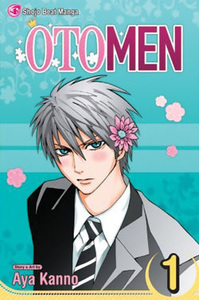Review
by Casey Brienza,Otomen
GN 1
| Synopsis: |  |
||
Asuka Masamune is a kendo champ who is also ranked in judo and karate. His classmates adore him for his handsome appearance and cool, masculine demeanor. But Asuka has a terrible secret: he's actually an “otomen” who loves girly things like cooking, cleaning, sewing, and reading shoujo manga. Only his unlikely friend Juta Tachibana knows the truth, and he has secrets of his own that he wishes to keep hidden. Now Asuka has fallen head over heels in love, in the style of his beloved shoujo manga, with the transfer student Ryo Miyakozuka, a young woman who, despite her charm, proves to be anything but the perfect girl herself. |
|||
| Review: | |||
Wondering just what “otomen” means? Take a look at the first cover illustration of the first volume of Otomen and note the stern looking young man with the incongruous pink flower tucked behind his ear. Still wondering? Okay, to quote the beginning of the second chapter: “Otomen—a male who has feminine hobbies and skills and a feminine way of thinking. A girlish guy.” Wow, that's quite a mouthful, isn't it? Too bad the Viz Media edition of the manga does not bother providing an equally tedious explanation of the joke behind it all—“otomen” is a Japlish pun that combines the Japanese word, “otome” (maiden), with the English word, “men.” A more efficient translation of the title of this romantic comedy by Aya Kanno (Soul Rescue, Blank Slate) which turns clichés on their heads would be something like “She-Man.” Of course, “She-Man”—and “otomen” as well—must be distinguished from slang words like “she-male,” which is porn video slang for a male-to-female transsexual. Asuka is definitely not a transsexual; he is painfully aware of his biological sex, but he still likes girly things. Incidentally, it's his dad who is the real transsexual, and briefly alluded to familial trauma—the detailed back story has sadly been bracketed for what one can hope will be future installments—in the wake of his father's gender identity crisis forced Asuka into the closet with regards to his feminine urges. His classmates are all convinced that he is the perfect manly man. Only his close friends, who share his beautiful, home-cooked bento with him, know the truth. Too bad the truth of the matter is that Otomen is, at its heart, just another shoujo romantic comedy. Yes, there is that added frisson of psychosexual angst and a monkey's barrel of jokes about gender stereotypes, good for bonus points. Yet a lot of it feels like wasted opportunity, and basically Asuka is your pure-hearted heroine type who cannot quite bring herself—whoops, himself—to confess his love for the sincere but oblivious boy—who, in the style of Otomen's gender reversals, is actually a girl with the boyish name of Ryo. Naturally, their relationship goes absolutely nowhere fast, and she doesn't realize that he loves her—even when he tells her outright. (Don't ask. It has to do with ambiguities of the Japanese language.) Unfortunately, even the laugh-o-meter seems to drop off significantly after the first couple of chapters, as if Kanno ran out of obvious ideas very quickly, so there is little to distract readers from the fact that they are supposed to have read this exact same story a thousand times before in a manga magazine with a title that sounds suspiciously like “Hana to Mame.” And lest you forget for an instant that this is familiar territory, there to remind readers to laugh at the ridiculousness of the requisite genre codes is fellow classmate and sidekick Juta Tachibana, who secretly moonlights as the creator of the hit shoujo manga Love Chick. Asuka is a fan, naturally, and he thrills at the fact that the heroine is also named Asuka. But little does he know that Juta is using him for inspiration…and boy is he oblivious when confronted with what should have been irrefutable evidence. Ah well. Juta, in addition to being a post-modern insertion, is still a bit of a question mark, and he is easily the most interesting character of the series. Which, sadly, isn't necessarily saying that much. Still, Otomen is, after all is said and done, certain to be a fan favorite. As long as you take it for the puffery that it is, do not tire easily of its gimmicky raison d'entre, and are not offended by the implication that the perfect woman can only be a man, this is a fun manga series. Kanno's artwork is without question a considerable asset—detailed, fine-lined, and attractive—and she has improved dramatically since her debut. She executes various shoujo and shounen manga visual styles with confidence and with her own signature flair. And truth be told, she may have found her creative calling in this ongoing series: She is able to marry her background as a shounen mangaka's assistant with the exigencies of the shoujo manga genre which employs her…while demonstrating impressive fluency in both. |
|
The views and opinions expressed in this article are solely those of the author(s) and do not necessarily represent the views of Anime News Network, its employees, owners, or sponsors.
|
| Grade: | |||
Overall : B+
Story : B
Art : B+
+ A silly send up of the gender stereotypes and the shoujo manga genre. |
|||
| discuss this in the forum (10 posts) | | |||
| Production Info: | ||
|
Full encyclopedia details about Release information about |
||